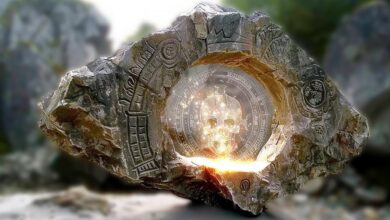James Webb Telescope FINALLY Found What NASA Was Hiding On Pluto All Along!

The James Webb Space Telescope is upending many previous ideas, forcing scientists to rewrite textbooks on the origins of the universe. With unprecedented observational capabilities, James Webb has opened the door to the most distant regions of the universe, leading to many surprising discoveries, especially about Pluto.
Once considered an icy, desolate world on the edge of the Solar System, Pluto is now a dwarf planet full of surprises and complexities. Before James Webb was born, studies of Pluto relied mainly on telescopes on Earth, which were limited in their ability to record details. Now, thanks to James Webb’s infrared technology, scientists have discovered features hidden behind Pluto’s ice and atmosphere. One of the most remarkable discoveries is the possibility of a subsurface ocean beneath Pluto’s icy surface, something once thought impossible due to the cold temperatures.
This information not only changes the way we think about Pluto, but also raises the possibility of life in the most extreme environments. Liquid water, the basis for life, may be maintained by the heat radiating from Pluto’s core. The discovery suggests that life may exist in many more places than we thought, even beyond the traditional “habitable zone” around stars.

In addition, Pluto’s surface is much richer and more diverse than initially thought. Sharp images from James Webb reveal mountains of water ice, vast areas of nitrogen ice, and mysterious red patches that may be tholins – organic compounds formed when methane interacts with ultraviolet or cosmic rays. These tholins may contain important information about the chemical activities on Pluto, even linking them to the early chemical processes that existed on Earth before life emerged.
In addition, Pluto’s moons, especially Charon, have also become the focus of research. James Webb discovered signs of tectonic activity and ice volcanoes on the surface of Charon, suggesting that the dwarf planet and its moon are not static but are constantly undergoing geological changes within.
James Webb’s discoveries on Pluto not only expanded our understanding of the Solar System, but also spurred research on other icy worlds such as Europa, Enceladus and Triton. The possibility of a subsurface ocean on Pluto suggests that liquid water and even life may exist in remote, cold environments in outer space.

James Webb has demonstrated that even forgotten dwarf planets like Pluto hold countless secrets. These discoveries not only change our view of Pluto, but also open up new prospects for the search for life in the universe, thereby affirming the importance of continuing to invest in space science and advanced technology.
The Solar System has a long history of formation and evolution, and one of the largest bodies in the Kuiper Belt, which is believed to contain the most primitive material in the Solar System, is Pluto. Scientists can learn more about the history of the Solar System, including how the planets formed and moved to their current positions, by studying Pluto. Observations from the James Webb Space Telescope are providing new information about the chemical composition of Pluto’s atmosphere and surface, helping us better understand the formation mechanisms of not only this body but also other Kuiper Belt objects.
The special relationship between Pluto and its largest moon, Charon, is a clear demonstration of the complex interactions between planets and satellites. Because Charon is nearly as large as Pluto, the two bodies are often referred to as a “dwarf planet binary” and are tidally locked, meaning they are always facing each other. Understanding the geological and atmospheric dynamics of the pair through the James Webb Space Telescope will not only help us figure out how dwarf planet systems form and evolve, but could also provide important information about other distant exoplanetary systems.
The surprising findings from Pluto have prompted scientists to reconsider other icy worlds in the Solar System. If a small, frigid body like Pluto can have complex geological activity, then other Kuiper Belt objects or moons of gas giants like Neptune and Uranus might have similar features. For example, Triton, Neptune’s largest moon, is thought to have a subsurface ocean and a geologically active surface. The James Webb Space Telescope’s discovery of Pluto opens up new opportunities for searching for life and studying distant celestial bodies.
One of the most remarkable discoveries is the possibility that Pluto has a subsurface ocean beneath its thick ice layer. This challenges the traditional notion that only large planets with strong gravity and a thick atmosphere can sustain long-term geological activity. In particular, the gravitational interaction between Pluto and Charon may create “tidal heating”, which heats and keeps underground water from freezing. This phenomenon, which has been detected on moons such as Europa and Enceladus, appears surprisingly on Pluto.

In addition, cryo-volcanism may be responsible for changes on Pluto’s surface, as substances such as water, ammonia or methane are ejected from the interior. The Sputnik Planitia region, a heart-shaped nitrogen ice plain, shows signs of youthful geology with few impact craters, suggesting that resurfacing is still ongoing. This suggests that geological activity on Pluto may continue to this day.
These discoveries not only change our view of the Kuiper Belt, but also extend the scope of our study to the moons of the gas giants, where similar conditions may exist. Pluto’s inner ocean raises the possibility of a habitable environment, similar to Earth’s deep-sea hydrothermal vents, where bacteria and other organisms rely on chemical energy instead of sunlight. If these conditions are present on other distant worlds, the possibilities for life in the universe may be much broader than previously thought.
Finally, the results from the James Webb Space Telescope have prompted a reassessment of the current planetary science paradigm. We may have to rethink our view of how small planets and moons behave and evolve. Pluto may not be just an icy relic from the early days of the Solar System, but rather a dynamic world with complex geology and hydrosphere, opening a new era for the study of icy bodies in and beyond the Solar System.








